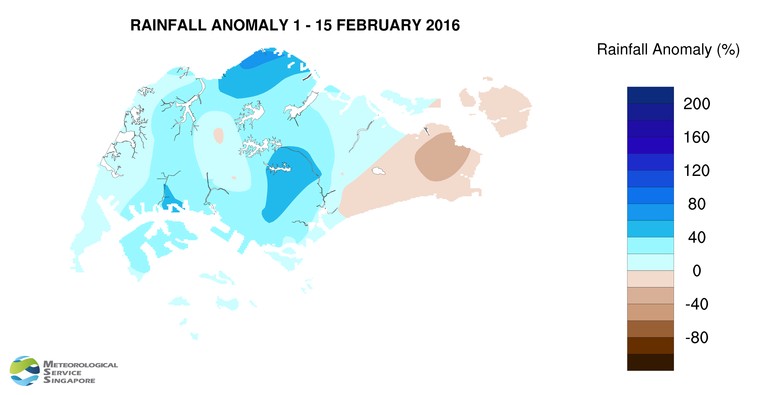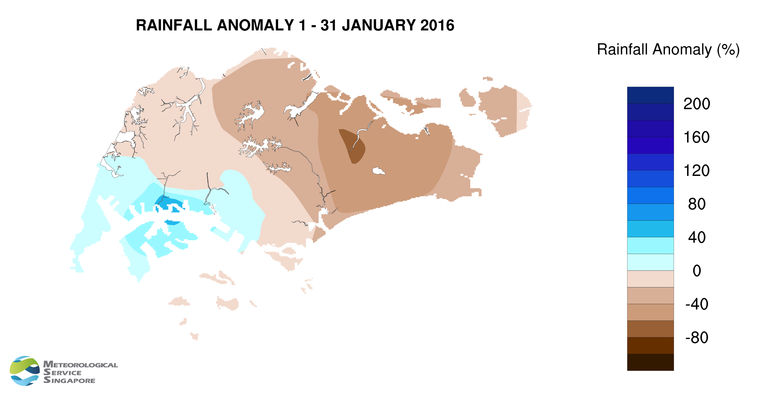Short-duration thundery showers on some days
Advisory
Singapore, 16 February 2016 – For the next fortnight, Northeast Monsoon conditions are forecast to persist with the low level winds blowing predominantly from the north or northeast. The prevailing wet phase of the Northeast Monsoon season is expected to gradually transition to the dry phase of the season around the last week of the month. The dry phase of the Northeast Monsoon season is characterised by drier weather and occasionally windy conditions.
2. For the rest of February 2016, localised short-duration thundery showers are expected on 5 to 6 days in the afternoon due to strong solar heating of land areas and convergence of winds in the surrounding vicinity. Rainfall for February 2016 is expected to be near average.
3. It is expected to be drier and warmer in the second half of February 2016 compared to the first two weeks of the month. The temperature for the next fortnight is forecast to range between 25°C and 34°C. The mean monthly temperature for February 2016 is likely to be warmer than the long-term mean of 27.1°C for February. February 2016 could rank among the top five warmest February since records started in 1929.
Review (1 – 15 February 2016)
4. Northeast Monsoon conditions prevailed during the first fortnight of February 2016 with the low level winds over the region blowing predominantly from the northeast. During the Chinese New Year period (7 – 10 February 2016), a monsoon surge brought occasional windy conditions and moderate to heavy rain to areas in the southern South China Sea region.
5. On 7 February 2016, the monsoon surge brought widespread moderate rain to Singapore. The rain occurred from around midnight to the early afternoon, and the highest total daily rainfall recorded was 46.8mm over the northwestern part of the island. For the next three days (8 to 10 February 2016), with a shift in the winds to blow from the north, Singapore experienced cool, cloudy and occasional windy conditions with brief periods of light to moderate rain. Most of the heavy rain as a result of the surge fell over the sea areas to the south of Singapore. Daily maximum temperatures of below 30°C were recorded in Singapore on consecutive days during the Chinese New Year period.
6. For the rest of the review period, Singapore experienced thundery showers mostly in the afternoons and evenings due to strong solar heating of land areas coupled with localised wind convergence. The showers were heaviest on 12 February 2016 where the highest total daily rainfall recorded was 60.2mm around Ang Mo Kio.
7. Most parts of Singapore received above average rainfall in the first half of February 2016. The highest rainfall 125mm (72% above average) was recorded over the northern part of Singapore around Woodlands. Rainfall was lowest over the eastern part of Singapore around Changi, where 41mm (28% below average) was recorded.
8. There were a few warm days during the review period where the highest daily maximum temperature recorded ranged from 33.8°C to 34°C. The lowest daily minimum temperature recorded on a few days was between 21.5°C and 23.5°C. Despite the cooler weather experienced between 7 and 10 February 2016, the mean daily minimum temperature in the first fortnight of February 2016 was 25.9°C which is significantly warmer than the long-term mean of 24.3°C. In addition, the mean daily temperature of 28°C is warmer than the long-term February climatology of 27.1°C.
CLIMATE STATION STATISTICS FOR FEBRUARY (Climatological reference period: 1981 – 2010)
| Mean daily maximum temperature | 31.7 degrees Celsius |
| Mean daily minimum temperature | 24.3 degrees Celsius |
| Mean monthly temperature | 27.1 degrees Celsius |
| Mean rainfall for the month | 112.8 mm |
| Mean number of rain days | 8 |
| Highest monthly mean daily maximum temperature | 33.5 degrees Celsius (2010) |
| Lowest monthly mean daily minimum temperature | 23.0 degrees Celsius (1982) |
| Highest monthly rainfall | 470.4 mm (1984) |
| Lowest monthly rainfall | 0.2 mm (2014) |



